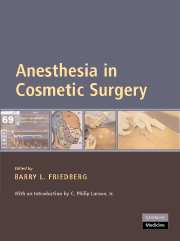Book contents
- Frontmatter
- Contents
- Foreword
- Acknowledgments
- Introduction
- Preface
- List of Contributors
- PART I MINIMALLY INVASIVE ANESTHESIA (MIA)Ⓡ FOR MINIMALLY INVASIVE SURGERY
- PART II ALTERNATIVE ANESTHESIA APPROACHES IN COSMETIC SURGERY
- PART III OTHER CONSIDERATIONS FOR ANESTHESIA IN COSMETIC SURGERY
- APPENDIX A A Guide to Perioperative Nutrition
- APPENDIX B Reflections on Thirty Years as an Expert Witness
- Index
- References
APPENDIX B - Reflections on Thirty Years as an Expert Witness
Published online by Cambridge University Press: 22 August 2009
- Frontmatter
- Contents
- Foreword
- Acknowledgments
- Introduction
- Preface
- List of Contributors
- PART I MINIMALLY INVASIVE ANESTHESIA (MIA)Ⓡ FOR MINIMALLY INVASIVE SURGERY
- PART II ALTERNATIVE ANESTHESIA APPROACHES IN COSMETIC SURGERY
- PART III OTHER CONSIDERATIONS FOR ANESTHESIA IN COSMETIC SURGERY
- APPENDIX A A Guide to Perioperative Nutrition
- APPENDIX B Reflections on Thirty Years as an Expert Witness
- Index
- References
Summary
INTRODUCTION
Threat of malpractice litigation is a fact of life in American Medicine and well recognized. That the threat and its costs vary greatly by both specialty and geography is equally well recognized (e.g., an academic anesthesiologist in Philadelphia pays more than three times what comparable insurance costs in San Francisco). Physicians in California credit the Medical Injury Compensation Reform Act (MICRA) of 1975 for their low premiums and physicians in Pennsylvania attribute high premiums to an inability to convince the state legislature to pass a “MICRA” equivalent. This failure currently has the potential to effect healthcare in Pennsylvania adversely. For example:
Premiums for category 5 (highest risk) specialists are more than $200,000 annually.
Young physicians trained in high-risk specialties are electing to go elsewhere.
Hospitals are closing labor and delivery suites to avoid carrying insurance coverage for same.
On the positive side, in Pennsylvania, anesthesia has moved progressively from category 5 to category 3 over the past twenty years. This move reflects the national improvement in the safety of the anesthetized patient (Fig. B-1).
WHO CAN BE AN EXPERT WITNESS?
Most witnesses in a trial do not express an opinion – that is, they only testify to the events which they have “witnessed” or to the facts as they know them. In contrast, expert witnesses are specifically recruited by lawyers on both sides of a case to express their opinions on the issue, especially on medical malpractice cases.
- Type
- Chapter
- Information
- Anesthesia in Cosmetic Surgery , pp. 248 - 256Publisher: Cambridge University PressPrint publication year: 2007

